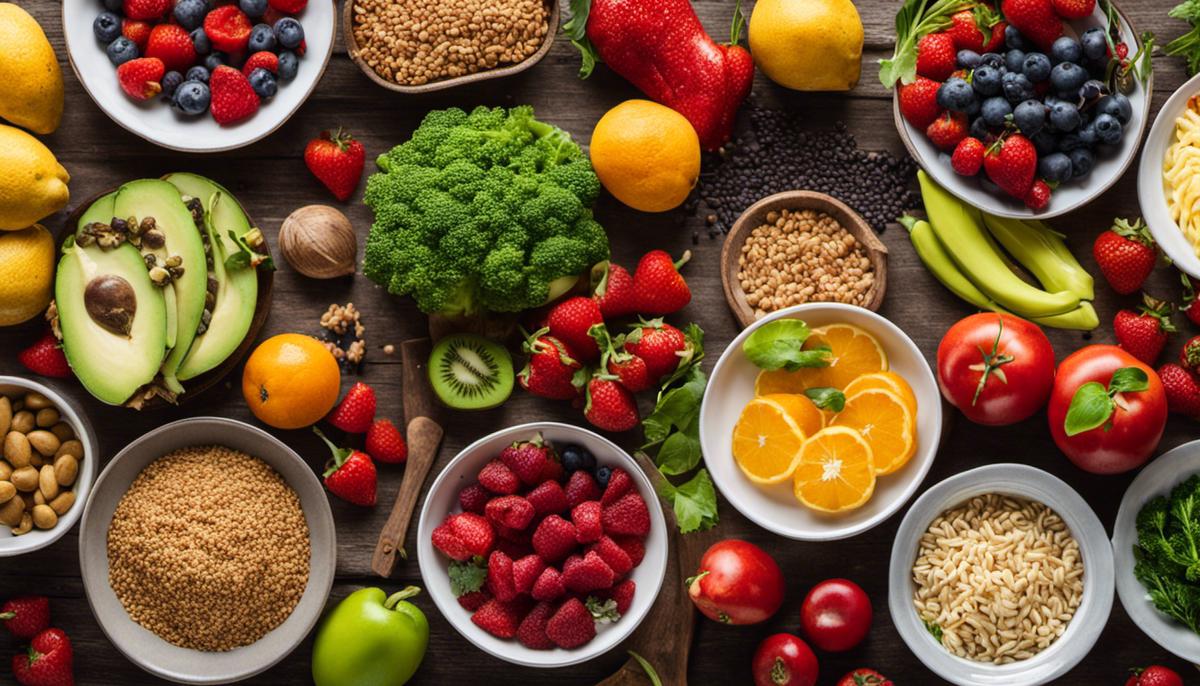In our quest for a healthy lifestyle, the choices we make in our daily nutritional intake play a vital role, specifically for maintaining heart health. The links between diet, heart disease, and stroke are robust and well documented by various scholarly studies. Grasping nutritional information, utilizing heart-healthy cooking techniques, and learning how to plan and prepare heart-friendly recipes are essential strategies in this pursuit. This light will guide you to understand the real impact of dietary components, such as fats, fiber, sodium, and sugars, on your heart. Whilst elaborating on several heart- sustaining methods including broiling, grilling, roasting, steaming, and sautéing. Also, we will skim through the step-by-step guide on how to plan and prepare heart-friendly recipes.
Understanding Nutritional Information
Crafting Heart-Healthy Meals: Where Nutritional Information Plays its Vital Role
In the grand scheme of creating dishes that delight the senses, it’s crucial not to ignore an aspect that equally matters – the nutritional content. It isn’t enough that a meal look tantalizing or tastes divine, it should also contribute to your overall well-being. This becomes significantly more crucial when the aim is to construct heart-healthy meals.
Nutritional information is a compass that guides the culinary journey towards dishes that nourish the heart. It provides a clear view of what’s going into the food, including the vitamins, minerals, fats, carbs, and proteins that make up the dish. This knowledge is the key to creating meals that not only satiate the palate but also fortify the heart’s health.
First and foremost, nutritional information brings clarity about the presence of saturated and trans fat in food components. These are the notorious villains that raise the level of harmful LDL cholesterol, threatening to clog arteries and cause heart-related issues. Being aware of this information helps when selecting cooking ingredients, allowing anyone in the kitchen to choose oils and fats that contain heart-friendly unsaturated fats.
Then comes the turn of sodium, a seemingly harmless ingredient that could pose risks in excess. High sodium intake may lead to high blood pressure, a silent destroyer of heart health. Nutritional data comes to the rescue here too, helping curb the sodium intake while ensuring the meals remain flavorful.
A keen understanding of nutritional information also reveals the goodness of fiber – a heart’s silent protector. Found abundantly in fruits, vegetables, and whole grains, fiber plays a pivotal role in reducing heart disease risks. Knowing which foods are fiber-rich amps up the health quotient of every meal that’s whipped up.
Moreover, nutritional information could also help in understanding the sugar content of meal components, vital when creating heart-healthy meals. Excessive sugar intake can lead to weight gain, increasing the risk of heart diseases. Thus, armed with this knowledge, it becomes easier to prevent inadvertent sugar overload in meals, keeping them sweetly wholesome.
Creating heart-healthy food isn’t about a complete overhaul of eating habits but more about making smart choices. Nutritional information plays a vital role in this, helping to understand what goes into the meals and how they affect overall health.
It’s about adding more heart-loving ingredients and techniques into the culinary repertoire. It’s about swapping out harmful elements in favor of those that boost heart health. It’s about being cognizant of the fact that every ingredient that goes into a dish has the potential to make or break heart-healthy goals.
In the end, crafting heart-healthy meals becomes an art form, an amalgamation of flavors, and a testament of love for oneself and for those shared meals are meant to nourish. Nutritional information becomes the brush that paints this picture of gastronomic and heart-loving delights. Bon Appétit!

Heart-Healthy Cooking Techniques
Embracing Heart-Healthy Cooking Techniques: Taste and Well-being in Perfect Harmony
If the tapestry of heart-healthy eating was the canvas, our cooking techniques would be the strokes of the paint brush, guiding our journey towards a more vibrant, healthy heart. Notably, cooking methods can have a monumental impact on the nutritional value of our food, requiring a thoughtful, calculated approach in the kitchen.
Steaming: The Exquisite Whispers of Flavor
Steaming is the paragon of heart-friendly cooking techniques and the essence of subtle, nuanced flavors. The moist heat gently cooks the food, preserving the integrity of heart-loving vitamins and minerals. Perfect for vegetables, fish, and even some types of meat, it’s a method that abstains from unwanted fats and oils, making it a key player in a heart-healthy diet.
Roasting and Grilling: The Ballet of Savor and Health
The high heat and rapid cooking of roasting and grilling work wonders in releasing the deep, natural flavors in foods- all while maintaining their nutritional profile. Keen to avoid any excess fat? Opt for a rack when roasting to allow fats to drip away from the food, and similarly, grill on an angle to permit unwanted fats to run off.
Sautéing and Stir-Frying: The Dance Between Speed and Flavor
These quick-cooking techniques rely on a small amount of oil, providing us with control over the type and amount of fat used. Remember, the use of heart-healthy oils such as olive, avocado or canola oil can significantly upgrade your heart health scoreboard. Sautéing and stir-frying reserve the crunch and vivid hues of vegetables, keeping friend nutrients on your plate rather than in the cooking water.
Poaching: The Methuselah of Delicate Cooking
A technique as ancient as poaching sounds like an unlikely contender, but do not be fooled! Poaching gently simmers food in a flavorsome liquid, eliminating the need for added fats while keeping meats tender and moist. Ideal for eggs, chicken and fish, poaching is a masterclass in heart-healthy cooking.
Slow Cooking: The Symphony of Low and Slow
Slow cooking, despite having a polar-opposite rhythm to sautéing and stir-frying, provides us with an avenue towards tender texture and infused flavors with minimal added fat. The slow, low-heat cooking beautifully melds flavors together while preserving nutritional value – a true testament to the potency of patience.
In this journey towards heart-healthy eating, let these cooking techniques be your guide, your mentors. Allow them to help you reimagine your cooking habits, each method dancing to the beat of hearty health. After all, taking care of our hearts does not mean forgetting about culinary pleasure, it simply means choosing to flavor our food in ways that keep us savoring every heart-healthy bite throughout this beautiful journey we call life. Remember – the art of food is not only in the taste, but also in the love and care we put into its preparation.

Planning & Preparing Heart-Healthy Recipes
With all that in mind, let’s now navigate through the world of spices, herbs, and other flavor enhancers that can help us turn your heart-healthy meals into culinary masterpieces that taste as riveting as they look. Food, infused with zesty herbs, aromatic spices and fresh produce, can take your taste buds on an epicurean journey without straining your heart health.
Breaking away from the monotonous belief that heart-healthy food is tasteless, spices not only add an entirely new dimension of flavor, but they often boast anti-inflammatory properties, a bonus for heart health. Fragrant ingredients like fresh basil, cilantro, and rosemary, or spices like turmeric, cumin, and cinnamon, can elevate simple, nutritious ingredients to a gourmet level. If you’re accustomed to heavy sauces or high-sodium seasonings, try branching out. The goal is to tantalize your palate with new tastes while embracing healthier ways of cooking.
Speaking of sodium, let’s delve into the topic of replacing table salt. Consuming less salt doesn’t mean that you have to sacrifice flavor. Substituting salt with fresh lemon or lime juice or vinegar can brighten the flavor of food, giving it a vibrant kick. Sodium-free spice blends are another great alternative to add depth to your dishes.
Next, consider heart-healthy substitutions. Ever tried ripe avocado as a spread instead of butter? Or almond milk in place of regular milk? These seemingly small changes can reduce your intake of saturated fats and introduce a host of beneficial nutrients into your diet. Even whole-grains can offer a delicious, nutty flavor alternative to white flour, along with providing necessary fiber that’s work wonders for your heart.
Healthy desserts are also very much a part of the heart-healthy journey. Opt for natural sweeteners like pure maple syrup, honey, or dates, rather than table sugar. You can also dish up desserts that use dark chocolate, rich in flavonoids, which are beneficial plant chemicals that increase the flexibility of blood vessels – perfect after-chocolate bliss.
Incorporating abundant fresh fruits and vegetables with vibrant colors and textures can also create visually appealing meals that are also high in antioxidants, vitamins, and fiber. From emerald greens to ruby reds, sunny yellows to deep purples – every color adds a different nutrient to your plate, and your heart.
Here’s the delicious truth: you’re essentially the artist in your kitchen, and these methods, spices, flavors, and techniques are your palette. Each meal you prepare is a canvas waiting to be brought to life with creativity and love for good health. The key is to remain curious, enjoy the process, and never shy away from experimenting with different heart-healthy elements. So, seize the day, embrace the joy of heart-healthy cooking, and let your culinary journey begin. Enjoy the ride!

The journey towards a heart-healthy lifestyle is not just a matter of choice, but a vital necessity for a robust and fulfilling life. As we understand the depths of nutritional information, the right ways of applying heart-healthy cooking techniques, and the planning and preparation of heart-nourishing recipes, we can effectively steer our health into the right direction. Remember, including adequate amounts of fruits, vegetables, whole grains, lean proteins, and heart-healthy fats in our meals can dramatically reduce our risk of heart diseases. Let us all strive for a healthier heart, a healthier life, one meal at a time!





